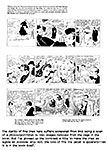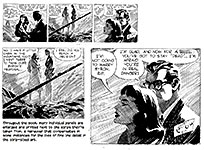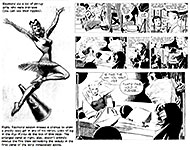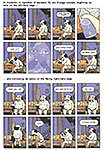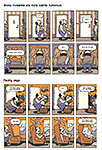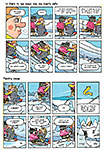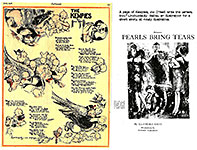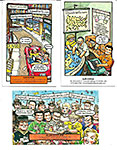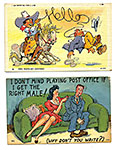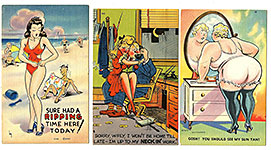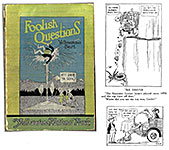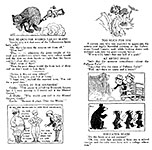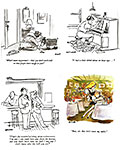 |
||||||||||||||||||||||||||||||
Opus 354 (June 17, 2016). Our hopped up report on the National Cartoonists Society Reubens Weekend in Memphis (and at Graceland) is the Big Story this time. We also destroy “Captain America: Civil War” and review the scholarly Frank Miller’s Daredevil and the Ends of Heroism, the new Alex Raymond art book, and the graphic novel The Book of Hope. We also offer a glimpse of the new Hellboy action figure and report Mignola’s decision to leave the book, update Mark Russell’s Prez satire, ponder the last Snyder/Capullo issues of Batman, and revisit the time Muhammad Ali whupped Superman in 1978 (while Ali was between his second and third championships). We also look at some old postcards, an old magazine, the current crop of editoons, and the passing of The New Yorker’s Frank Modell. Here’s what’s here, by department, in order—:
NOUS R US Orlando Massacre Print Comics Thriving in Digital Universe Comixology Forging Ahead in Digital Bill Griffith’s 10 Rules for Drawing Comics Comics Musicals: Wimpy and Cul de Sac Zapiro Admits Monkey Was a Mistake Odds & Addenda—: More Live-Action Versions of Disney Animations Captain America: Civil War Captain America a Fascist? Rebirth and Dr. Manhattan
NCS REUBEN AWARDS WEEKEND Seminars Summarized Peabody Ducks Graceland and Elvis’ End Silver Reubens Analyzed
HELLBOY NEWS Superb Action Figure Mignola Quits Hellboy Stories
FUNNYBOOK FAN FARE Up-dating Prez Muhammad Ali Whups Superman (1978) Neal Adams Draws Wonder Woman’s Butt Scott Snyder/Greg Capullo’s Last Batman (For Now)
EDITOONERY Reviewing the Last Month’s Crop Hillary Blisters Trump in Foreign Policy Speech
THE FROTH ESTATE Trump Lies—PolitiFact Trump Is Entertainment, Not Politics
NEWSPAPER COMICS PAGE VIGIL Death in Crankshaft—for a Whole Month The Rest of Jake Tapper’s Dilbert Week
BOOK MARQUEE Frank Miller’s Daredevil and the Ends of Heroism
BOOK REVIEW Alex Raymond: An Artistic Journey
LONG FORM PAGINATED CARTOON STRIPS The Book of Hope
COLLECTORS’ CORNICHE Postcards and Old Mags
ONWARD, THE SPREADING PUNDITRY Trump Lies PASSIN’ THROUGH The New Yorker’s Frank Modell
QUOTE OF THE MONTH If Not of A Lifetime “Goddamn it, you’ve got to be kind.”—Kurt Vonnegut
Our Motto: It takes all kinds. Live and let live. Wear glasses if you need ’em. But it’s hard to live by this axiom in the Age of Tea Baggers, so we’ve added another motto:.
Seven days without comics makes one weak. (You can’t have too many mottos.)
And our customary reminder: don’t forget to activate the “Bathroom Button” by clicking on the “print friendly version” so you can print off a copy of just this installment for reading later, at your leisure while enthroned. Without further adieu, then, here we go—:
NOUS R US Some of All the News That Gives Us Fits
JUST AS WE WERE ABOUT TO SEND THIS OFF to our Webmaster (Jeremy Lambros, in Japan), we were bombarded with reports of the massacre in the early morning hours on Sunday at a gay nightclub in Orlando. Amid all the dozens of comments in its wake were the speeches by the two candidates for Prez. Watching Trump’s bombastardy, we were amazed to see the fabulist world he’s managed to conjure up out of the vast well of his ignorance, accompanied by an even more frenzied than usual racist rant, appealing to fear and fostering hatred. Hey, Trumpster—law enforcement and American Muslim communities are already working together to find terrorists before they strike. The Trumpet is not just an asshole: he’s a roaring asshole. In sharp contrast, we have Hillary’s humane appeal to our courageous better angels as she urged us to continue to tolerate diversity and to reject hatred while indicating pragmatic directions we should go to strengthen resolve and tackle problems (such as the too easy availability of “weapons of war,” as she so aptly called them). Out of the buffoon’s rant, we drew only despair: his plans are too vast to be practical. Out of Hillary’s calm reason, we drew resolve. And hope. Which is a leader for our times? Editorial
cartoonists, like cartoonists in every corner, don’t find anything funny about
the massacre of unarmed, innocent civilians. Many of the earliest cartoons
deployed a gay flag—rainbow bands of color—riddled with bullets or bloodied.
Others had Lincoln or the Statue of Liberty weeping rainbow tears. Near here
are four of the earliest responses that used other visual metaphors. At the upper left, Gary McCoy, inspired by the initial reports of 50 dead, drew an American flag with its 50 stars darkened. The black star-shaped holes denote grief as well as what is missing. Next around the clock, Canada’s Aislin (aka Terry Mosher, who has taken his older daughter’s name as his pen name) depicts the U.S. as a jumble of weaponry. The picture may not be too clear at this remove in reproduction, but you can probably make out the rifle for lower California and the gun barrel for Florida. The rest of the country is just a heap of firearm hardware. At the lower right, Scott Stantis turns us away from grief to defiance. “Hate” is depicted as a looming giant, but he can be defeated by even small persons if they employ joy, love and humanity. Solid black underscores the bleak grimness of the threat. Finally, Henry Payne rips holes in the Trumpster’s plan: neither the Wall nor a “no Muslims” immigration policy would have stopped the Orlando shooter, who was born in Queens, New York (not, as the Trumpet proclaimed, in Afghanistan). Payne, by the way, is a devoted conservative. And like virtually all of his breed of editoonist, he doesn’t like Trump much. Daryl Cagle, a political cartoonist who runs a syndicate distributing editorial cartoons world-wide, recently made this observation: “I get mail from readers who wonder why we don’t post pro-Trump cartoons. The answer is: we don’t have any pro-Trump cartoons. I don’t know any cartoonists who are pro-Trump.” The
reason may be evident in our next visual aid, a cartoon by Randy Enos. Said Cagle: “They insisted we should nave never posted it” on the CagleCartoons.com site, by which means it is offered to sale to subscribing newspapers. Yeh, but—nobody forces an editor to buy any of the cartoons distributed by this means. Editors can pick and choose. Editors who didn’t like Enos’ cartoon could choose not to use it. So what’s the fuss about? More noxious Trumpery: the only opinion that matters is “mine.” Phooey. But, speaking of opinions that matter—there’s mine about waging war on terrorism Maybe now—in the wake of the most horrific of assaults on domestic tranquility, we’ll realize that the war against terror has a battlefield within our nation’s boundaries, and that we are all on that battlefield. There are no civilians; we’re all soldiers. We must gird ourselves for the battle, not tremble in fear. We must go forth in our usual pursuits, not hide behind governmental protections that are bound to fail from time to time, disappointing us all and prompting the call for more new laws that promise safety at the expense of liberties and deliver neither. The only way to have prevented the Orlando shooter from committing his heinous assault on innocent people would have been to lock him up the minute he showed up several years ago on the FBI’s list of suspicious characters. They interviewed him and saw nothing alarming. There are those who say he should have been imprisoned simply because he was suspicious. Not here. Not in this country. Not if we value our freedom more than the illusion of our safety. And we should. That’s the patriot’s way. And now that we’re all soldiers on the battlefield, we must take the patriot’s way. We can solve the TSA problem by simply dispensing with the security service. The airport—and the airplanes and the sky above—are parts of the battlefield. Enough sermonizing. Onward.
IN THE DIGITAL AGE, PRINT COMICS THRIVE The digital revolution has wreaked havoc in nearly every corner in the print publishing game—except, surprisingly, comic books. According to Tom DiChristopher at cnbc.com, print sales in comics are thriving alongside the rise of their digital counterparts. “Print comic book revenues have been on the rise in recent years,” DiChrisopher says, “even as digital comics' sales boom. Print receipts have held up at a time when publishers have introduced all-you-can-download subscriptions that offer thousands of comics for a flat monthly or annual fee.” In 2014, digital comics revenues excluding unlimited subscriptions reached $100 million, according to ICv2— up from just $1 million seven years ago, when ICv2 started collecting data. Meanwhile, the North American market for print comics grew from an estimated range of $650 to $700 million in 2009 to $835 million in 2014, according to ICv2 and the Comics Chronicle. That includes sales of single issues at comic shops and newsstands as well as book channel sales of trade paperbacks, or collected volumes of comics. There are signs digital comics are butting up against the law of large numbers. Sales growth slowed in 2014 to 11 percent, down from 29 percent in 2013 and 180 percent in 2012. In the coming years, it could be more difficult to keep growing the readership. Weekly circulation of newspapers is down 17 percent over the last decade, and advertising sales have plummeted more than 50 percent, according to Pew Research Center. Magazine ad revenue is forecast to see only minimal growth through 2019 on the strength of digital sales after five years of decline, according to PricewaterhouseCoopers. “To be sure,” DiChrisopher continues, “comics are relatively new to the digital domain [and as time passes, the situation for comics may change and parallel the fates of music and print media]. Creators have been uploading web comics since the rise of the commercial internet in the '90s. However, mainstream comics didn't migrate online in any significant numbers until smartphones and tablets became commonplace.”
COMIXOLOGY FORGING AHEAD IN DIGITAL Following its launch in 2007, ComiXology established itself as the dominant player in digital comics distribution — largely on the strength of its Guided View technology, which offered a more fluid reading experience than previous apps had afforded. Marvel Entertainment and DC Comics adopted Comixology's platform in their digital storefronts. And in the last week of May, Comixology pulled off a major surprise with the launch of Comixology Unlimited, a monthly subscription service that’s hoping to be the Netflix of comics, the Spotify of sequential art, the Marvel Unlimited of books not published by Marvel. Alex Spencer at comicsalliance.com reports that “the Twitter reaction since the launch suggests the news wasn’t just a surprise to readers, but to many of the creators involved too.”
BILL GRIFFITH'S 10 RULES Posted by Dov Torbin Bill Griffith did a Sunday Zippy recently in which he cited ten rules for drawing comics; here they are—: 1. Cartoon
characters have souls. 3. You're the auteur of your comic. You write, cast, light, film, direct and edit. You have
final cut.
COMICS THAT ARE MUSICALS Wimpy and Cul de Sac “Diary of a Wimpy Kid: The Musical” is a hit at the Children’s Theater Company in Minneapolis, reports Dominic P. Papatola. Reviews were strong and tickets were scarce, even with a week’s worth of added performances. As the production sprinted toward closing night June 12, a question hung over the boisterous proceedings: What’s next? Papatola joins the speculation that the show, based on Jeff Kinney’s wildly popular, illustration-dotted novels for young people, is eventually heading east, to a Broadway ever hungry for family-friendly fare. Soon, two shows aimed at that audience will be gone: “Matilda the Musical” is closing on January 1, and while “School of Rock the Musical” is a Tony-nominated hit, “Tuck Everlasting,’’ like “Wimpy Kid” an adaptation of a children’s book, turned out to be short-lived. As directed by Rachel Rockwell, “Wimpy Kid” is faithful to the books on which it’s based: The set is dominated by a gigantic sheet of notebook paper, which forms the backdrop and spills over into the orchestra pit. Meanwhile, in Washington, D.C., Encore Stage & Studio is currently showing their world premiere production of “Cul de Sac.” The play, written by Amy Thompson, is an adaptation of the popular comic strip of the same name by Richard Thompson (her husband, no less) and includes original music composed by Matthew Heap, reports Kendall Mostafavi at dcmetrotheaterarts.com. Alice Otterloop is the four year old star of the play just as she is of the comic strip, and the story deals with being one’s-self and the meaning of true friendship. Mostafavi notes that “Cul de Sac,” the play, does great justice to the original comic strip and its characters, proving to be a fun and silly show, with a touch of heart. The entire production is put on, as Encore says, “by kids, for kids” as the cast and crew. Playwright Thompson also designed and built the set and props. As in the Wimpy Kid musical, the set is built to look like a drawing, with the Otterloop’s house, a platform with a bed to represent Alice’s brother Petey’s room on the second floor, and the raised man-hole cover, which Alice is known to use frequently as her stage in the strip. “As in the strip,’ says Mostafavi, “Alice has a vivid imagination and the creative team does a wonderful job creating her thought bubbles as live-action. There is a larger platform stage left and, with the help of lighting, projections, and clever costuming, Alice’s fantasies are acted out on the raised stage, creating the illusion of being completely separate from the ‘real’ action on the stage. Many of the funniest moments of the play, are the characters’ imaginings, like Alice’s idea of what a Fish-slapping Bear would be, and the story-telling of Petey’s cartoon about Toad-Zombies.” The playwright, the cartoonist’s wife, is not without theatrical experience, as should be obvious. She has taught theater in educational settings, including the Folger Shakespeare Library in Washington, D.C.
ZAPIRO ADMITS THE MONKEY WAS A MISTAKE Editoonist Zapiro (aka Jonathan Shapiro), a conspicuous finger-pointing truth-teller in South Africa, drew a cartoon recently that depicted the country’s president, Jacob Zuma, as one of those sidewalk organ grinders with National Prosecuting Attorney Shaun Abrahams as his monkey. I haven’t seen the cartoon, but the message is pretty clear: Abrahams dances to Zuma’s tune. Suddenly, widespread outrage broke out, claiming that Zapiro’s portrayal of black people (presumably, one of them—Abrahams—as a monkey) was racist. Speaking to eNCA, Zapiro defended himself—and then admitted his mistake, as reported by Nomahlubi Jordaan at Rand Daily Mail. “I’ve had no problem offending,” said Zapiro. “I think it’s very much part of what cartoonists do and satirists do to have that license to offend and even sometimes to push the boundaries beyond those that society often thinks of and to really offend and take things further. “I’ve offended religious groups of all kinds and I’m not unhappy doing that. I’ve offended politicians for all sorts of things. I’ve been attacked because of the cartoons of Jacob Zuma. I can defend, I’d say‚ 99% of them. Occasionally‚ I make mistakes. This [the monkey and the organ grinder]‚ I see now as a mistake.”
ODDS & ADDENDA With Disney’s roll-out of a live-action CGI-assisted version of “Alice in Wonderland” comes news that the studio is planing live-action remakes of “Beauty and the Beast” and “Dumbo,” plus spin-offs of other films—“Cruella” from “101 Dalmatians,” “Tinkerbell” from “Peter Pan”— and a sequel to “Jungle Book.” I’d like to see a live elephant with ears big enough to flap like wings. Maybe that’s the CGI-assist part. ■
I went to see “Captain America: Civil War” and it was terrible. It was too
long. Too many fighting and grunting sequences. And except for Captain America
and Iron Man, I didn’t know any of the characters. None were properly
introduced. The viewer was wholly disoriented the entire time. This viewer,
anyhow. To enjoy—to even follow—the movie, you had to have seen all the other
Avenger movies, wherein the same actors portrayed the same iconic characters.
Then you’d know who everyone was. I think Scarlett Johansson was Black Widow;
she’s called Natasha once. But I’m not sure. ■ Is Captain America a fascist? Over at Marvel, George Gene Gustines reports at the nytimes.com, the first issue of Steve Rogers: Captain America sheds new light on the hero’s past that has a great effect on his present. This issue, written by Nick Spencer and drawn by Jesus Saiz, reveals that Rogers’s mother was recruited by Hydra, one of Marvel’s terrorist groups. Flash forward to today and Captain America is suddenly doing some terrible things: pushing an ally out of a plane and, on the last page, proclaiming, “Hail Hydra.” Since Hydra can easily be equated to Nazism, is Captain America a fascist? The disturbance on social media has yet to die down completely. ■ Over in the DC universe, Gustines continues, the 80-page special Rebirth reveals Dr. Manhattan, one of the heroes in Watchmen, by Alan Moore and Dave Gibbons, as the puppet master behind some recent troubles. Rebirth is written by Geoff Johns and drawn by a cadre of the DC’s top artists (Phil Jimenez and Ivan Reis among them). The story addresses some of the shortcomings of the company’s 2011 reboot, which made some characters younger, erased others and has generally made fans unhappy. “I hope to inspire passion, create connection and see the DC universe and its readers and fans embrace hope and optimism like its heroes do,” Johns said. “The world needs it more than ever.”
Fascinating Footnit. Much of the news retailed in the foregoing segment is culled from articles eventually indexed at rpi.edu/~bulloj/comxbib.html, the Comics Research Bibliography, maintained by Michael Rhode and John Bullough, which covers comic books, comic strips, animation, caricature, cartoons, bandes dessinees and related topics. It also provides links to numerous other sites that delve deeply into cartooning topics. For even more comics news, consult these four other sites: Mark Evanier’s povonline.com, Alan Gardner’s DailyCartoonist.com, Tom Spurgeon’s comicsreporter.com, and Michael Cavna at voices.washingtonpost.com./comic-riffs . For delving into the history of our beloved medium, you can’t go wrong by visiting Allan Holtz’s strippersguide.blogspot.com, where Allan regularly posts rare findings from his forays into the vast reaches of newspaper microfilm files hither and yon.
FURTHER ADO The Week reported (June 3) that International Olympics Committee announced that it would be handing out some 450,000 condoms to 10,500 athletes and staff during the 2016 Olympic Games in Rio de Janeiro, more than three times the number distributed at the London games four years ago. Let the games begin.
NCS REUBEN AWARDS WEEKEND National Cartoonists Society at Graceland
NCS met for its
70th annual convening May 27-29, 2016, in Memphis at the
125-year-old Peabody Hotel, famed for the ducks that waddle around the lobby
twice a day. Of the 280 persons in attendance, 152 were members; the rest were
spouses and children or syndicate officials and other hangers-on. Those who arrived a day early visited the St. Jude Children’s Research Hospital where they took a tour of the facility and drew pictures for the children. That evening, under the auspices of the NCS Foundation, they were treated to a barbeque dinner at a restaurant on Beale Street, famous for blues and rock ‘n’ roll. The schedule was free of programming on Friday morning and most of the day Sunday (except for two hour-long presentations at mid-day) to permit visiting numerous of the city’s attractions—Beale Street, Sun Studio (where Elvis and other musical notables got their starts), Betz Museum of Asian and Judaic Art, Cotton Museum, the National Civil Rights Museum (built around the old Lorraine Motel where Dr. Martin Luther King, Jr was killed), and various art museums—most of which are within walking distance of the hotel. I can summarize the content of the seminars briefly from the printed program itself; I don’t hear well enough to be able to report on what the presenters actually said, but the program notes adequately convey the intent of the sessions. On Friday afternoon, Doug Little and Joe Sliger talked about Wacom drawing devices, demonstrating several new Cintiq products. Then Luke McGarry (former NCS Prez Steve McGarry’s son, who has risen to surprising heights in the Society and elsewhere—described as “the most sought-after cartoonist/illustrator/animator in Los Angles”) showed his “cutting edge illustrations and videos” by way of illustrating how “today’s young illustrators use social media to build a fan-base and attract the attention of art directors.” In the next session, Jeff Smith and Terry Moore talked about their experiences creating and marketing their independent comic book series—respectively, Bone, RASL and Tuki Save the Humans; and Strangers in Paradise, Echo and Rachel Rising. Then Maria Scrivan discussed aspects of her career producing her syndicated daily panel, Half Full, as well writing and illustrating children’s books and licensing her cartoons. And, finally, Lynn Johnston (For Better or For Worse) and Deborah Peyton (Day to Day) walked us through the process of making fabric patterns from cartoon drawings, an enthusiastic endorsement of an “exciting new potential for creating and marketing your own wearable cartoon art.” After the Annual Business Meeting on Saturday morning, the program continued through the afternoon, beginning with Jan Eliot (Stone Soup), who recounted how, as a divorced mother of two, she started her cartooning career and made a success of it. Then The New Yorker’s Matthew Diffee did an hour’s hilarious stand-up comedy, illustrated by his own cartoons and other visual fragments of the universe, including a bagel that he threaded onto a string stretched across the stage so he could move it back and forth in order, he claimed, to indicate various points in his career. Next, Paul Coker, Jr, who would receive the Milton Caniff Lifetime Achievement
Award that evening, was On Sunday, David Apatoff, a former cartoonist turned lawyer, discussed copyright and trademark law and Jenny Robb, curator of the Billy Ireland Cartoon Library & Museum at Ohio State University, offered practical tips and advice about preserving our art and papers and urged donating art and archives to libraries and museums. The day’s second and final presentation was by Mad’s Sergio Aragones, who rehearsed some of his hysterical misadventures as a youth and as a young cartoonist, illustrated by his own drawings.
FOR THOSE SO
DISPOSED, the days were punctuated by the scheduled parade of ducks through the
Peabody lobby: promptly at 11 a.m. every day, five of the web-footed waterfowl
waddle out of an elevator and plunge into the pool surrounding the fountain in
the center of the lobby. They swim all day until 5 p.m., when, with ceremonial
escort, they return via elevator to their roost on the hotel roof. Legend has it that the tradition began in 1933 when Frank Schutt, general manager of the hotel, and a friend, Chip Barwick, returned from a weekend hunting trip to Arkansas. “The men had a little too much Tennessee sippin’ whiskey and thought it would be funny to place some of their live duck decoys (it was legal then for hunters to use live decoys) in the beautifully ornate lobby fountain.” Ducks in the fountain evidently caught on, appealing to some idiotic human sensibility, and successive generations of ducks have made a living at this pool performance. Twice a day, the lobby is jammed with human onlookers who watch, rapt, the ducks’ coming and going. “Today, the mallards are raised by a local farmer and friend of the hotel. The ducks live in the fountain [and on the hotel roof] until they are full grown and, on retirement from their Peabody duties, are returned to the wild.”
SUNDAY
EVENING’S VISIT TO GRACELAND was instructive. Originally a farm 9 miles from
downtown Memphis, it was bought late in the 19th century by Stephen
Toof, founder of the oldest printing firm in Memphis, who named it after his
daughter, Grace, who inherited the farm in 1894. The Colonial Revival style
mansion was built in 1939, and Elvis purchased it for $102,500 in 1957, seeking
to escape ravening crowds of fans who congregated continuously outside his home
in Memphis, annoying his neighbors as well as the object of their obsession.
Elvis spent another $500,000 remodeling the building to suit his needs and
adding other buildings on the grounds. Late in life, he took up horseback
riding and racquetball, and buildings were build to accommodate those
interests. Across the road from the mansion is an extensive layout of buildings—gift shoppes and a museum for Elvis’ expensive automobile collection, and snack and lunch facilities—none of which were present when the singer lived there. The tour of the Graceland mansion includes only the first floor and basement; the second floor remains living quarters. Despite the imposing facade, the building is relatively small, and the interior rooms are intimate rather than impressive. Each of us was supplied with headphones and an iPad so we could take self-conducted tours. With the iPad, you could actually take the tour without entering the building: the iPad pictured each of the rooms while discussing their individual features and Elvis’ use of them. Elvis himself is sometimes quoted in the audio part of the iPad tour. He is treated throughout with great respect and admiration. Whatever his faults, they aren’t mentioned. Nor is the manner of his death. St. Wikipedia explains: “Presley died in his bathroom at Graceland, allegedly of a heart attack. It was ‘a wall-to-wall red rug in an upstairs bathroom with three-inch pile in which Elvis died face down, having risen from his reputedly wall-hung black ceramic toilet with a seat padded in imitation black leather and having collapsed in the proximity of teddy bears, empty syringes, and an illustrated book of Asian derivation that coordinated the birth dates of men and women with certain cosmically optimal sexual positions.’” Which withal gave rise to the legend that the heart attack was brought on by his straining too much in an effort to evacuate his bowels. It’s a shitty story, but it makes a sort of cynical sense to persons who are not fans of Elvis. I like his singing but I’m not so sure about his personage. Back in the mid-1950s whilst incarcerated at Colorado University, I was once inspired to make a caricature of Elvis. I never got further than pencil sketches, which I post hereabouts for your vast amusement.
THE HIGHLIGHT OF THE WEEKEND was, of course, the Reuben Banquet on Saturday evening when the Reuben trophy is presented and the Silver Reubens winners are announced. I’ve reported these matters in detail at our last Bunny Bonus posting (editoonist Michael Ramirez won the Reuben as Cartoonist of the Year), but some of what I said there is strategically important to repeat, or allude to, here. Of the 15 Silver Reubens awarded, 9 were conferred upon persons who weren’t present to take possession of them. And 3 of the remaining 6 were to the same guy (Australian Anton Emdin, an extremely talented cartoonist who excels at his every endeavor). Nine no-shows conjures up an ugly thought: those nominees apparently don’t have a high enough regard for the NCS awards to come to the party that might celebrate their achievement. The divisions that fall into this category of seeming unimportance have for several years been the same ones—the ones outside the traditional purview of the Society’s members, newspaper and magazine gag cartooning. The outliers have usually been animation (both tv and feature film), comic books (including graphic novels), and online cartooning. Sad to say, this situation does not speak highly of NCS prestige. And that’s too bad: the Society has been conscientious, albeit terribly slow, in recognizing the emergence of cartooning in fields of endeavor other than syndicated newsprint. It took a long time before comic books were seen as award-worthy. The foot-dragging in this category doubtless reflects the assembly-line creative process in most comic book production. Written by one batch of persons and drawn by several specialists (backgrounds, lettering, etc.), the historic comic book left a crucial question unanswered: if the “creator” is to get an award, who, exactly, is the creator? The first NCS division award for comic books was conferred in 1956, ten years after the Society was founded. It went to Jerry Robinson, who, if memory serves (and, admittedly, it often doesn’t), was not drawing many comic books then. In recent years—at least the last twenty—comic books have increasingly been produced by smaller and smaller bunches of people. And a few lately have been signally the work of a pair of creators. Mark Waid and Chris Samnee in Daredevil. Matt Fraction and David Aja in the even more adventurously plotted and pictured Hawkeye. These teams have done significant work in the form—imaginative in both story and visualization. But NCS hasn’t recognized their achievement. Maybe too few NCS members work in comic books? This year’s winner in the funnybook category is Ben Caldwell who is drawing Prez, the highly satirical title about American presidential and congressional politics (about which, we’ll say more down the scroll); Caldwell’s drawing is nicely, even, sometimes, innovatively achieved, but the satire comes from the writer, Mark Russell. Where’s his award? And graphic novels suffer somewhat the same fate even though they are more often than not lately the work of a single creator. Why hasn’t Scott McCloud’s brilliant exploitation of the form in The Sculptor been recognized by NCS? Published in 2015, it was eligible for this round of Silver Reubens. So was Bill Griffith’s Invisible Ink. Other graphic novel achievements of recent years have also been ignored. Rick Geary’s historical true crime books. Peter Kuper’s The System. The list, unhappily, goes on and on. The no-shows started their rise to prominence several years ago. NCS management doubtless noticed this burgeoning void at the annual fete, and the result of their perception has been the growth of extraneous amusements that now infect the proceedings. Tom Gammill, who assumed the emcee post for a few outings over the past few years, introduced made-for-the-Reubens videos, and that kept everyone rolling in the aisles so much that no one seems to have noticed the dwindling prestige of NCS awards. This year’s program was full of such videos, plus skits and amateur theatricals and film clip cameo appearances of famous persons (weatherman personality Al Roker, Rachel Maddow—who pronounced herself a passionate fan of cartooning). Gag cartoonist Tom Stemmle was the star of one elaborate production with Broadway chorus-line ambitions: as he stood there lip-sincing the singing of a single, drawn-out note, another of the cast (maybe Australia’s Jason Chatfield?) silenced him with a pie in the face. A classic vaudevillian stunt. Stemmle told me later that the skit had been rehearsed earlier in the day, and that evening’s pie-in-the-face (actually, cheese cake dripping with strawberries) was his second of the day. I can understand the impulse to introduce variety into what would otherwise be a boring procession of presenters followed by acceptance speeches in the mode of the tedious Oscar ceremony. But this year, that impulse went, I ween, too far: it’s chief effect was to lengthen the evening, and the mind and risibilities can absorb only as much as the butt can endure. The wearier my butt, the less I appreciated the horseplay and goodly fellowship. By the time we arrived at the penultimate presentation, that of the Silver Reuben for editorial cartooning which went to animator/editoonist Ann Telnaes, I’m not sure everyone could appreciate her acceptance remarks. She told me that she didn’t have anything prepared to say (she thought Michael Ramirez would win, and he did—but he won the Reuben, not a Silver Reuben). But she took the occasion to express her appreciation for “the wonderful support I received from my cartooning colleagues during the Cruz cartoon controversy [see Opus 347] and how much it meant to me both professionally and personally. I also recalled standing with disbelief in front of my computer watching my twitter feed pile up with all those horrible comments [including scurrilous rape and death threats—the usual Tea Bagger swill] and then Stephan Pastis sent me this direct message: ‘Isn’t it great that a cartoon can still rile up so many people?’ Gave me my smile back.” Her remark gives us a suitable exit line. However awry the purposes of the Reuben Weekend may go in actual execution, the underlying reason for the convening is never frustrated: we gather for the assurance our mutual presence generates, telling us that, despite the solitary nature of the work, we are never alone in our cartooning endeavors. And that brings the smiles back.
HELLBOY NEWS Among the
numerous happily useless items in the goodie bag given out with our badges at
the NCS Registration Desk in Memphis was a Graphitti-designed action figure of Mike
Mignola’s Hellboy, 9 inches tall. A giant. Hellboy was in some goodie bags,
and in others, also from Graphitti, were similarly designed action figures for
Grendel and The Spirit. I got Hellboy, and I like it a lot. But I wouldn’t have
sneezed at The Spirit; maybe next time. The sealed plastic sarcophagus Hellboy came in was emblazoned with the following description of the character, the best orientation to Hellboy I’ve ever seen of this oft-baffling creation—: “Mike Mignola’s Hellboy, World’s Greatest Occult Detective. Actually, he’s not a very good detective at all, but he can take a beating and he means well. He was born in Hell and brought to earth by Nazi mad scientists and the undead ‘Mad Monk’ Rasputin in 1944. He looks like trouble and may actually be the Beast of the Apocalypse. For now, though, he’s a good guy, protecting mankind from vampires, werewolves, cannibal hags, flying heads, human fat giants and assorted other nameless horrors. He falls down a lot and often catches fire, but he’s a good man (or boy) in a tight spot, and we of the Earth are happy to have him.” On the front of the package we learn that the figure is accompanied by “Cloth Jacket, Interchangeable Hand, Sword, and Big Ass Gun.” Can’t do better than that, kimo sabe.
And Then Mignola Quits!!!! Mike Mignola has just announced that he’s giving up Hellboy comics and taking a year off to get away from comics and paint (“although,” Alex Dueben adds at suicidegirls.com, “he admits that it’s really a year of trying to figure out what he’s going to do for the rest of his life”). I suppose that the character’s having finally produced one of the best action figures on the market, Mignola thinks there are no mountains left to climb. But leaving the character wasn’t easy. Mignola admitted to Jeffrey Renaud at comicbookresources.com that “drawing the last page [in the last book, No.10 of Hellboy in Hell] was really difficult.” “I’d always known what I was going to do,” he told Meredith Woerner at latimes.com, “but when it came down to actually doing it, I kind of lost my nerve. I didn’t lose it completely, but I did kind of keep waffling back and forth. It’s one thing to say you’re going to do this weird thing, it’s another thing to actually do it.” He told Renaud: “When it came right down to doing it I thought, can I really get away with this? That was the most angst I had on the entire series, doing the last page. Then it was just amazingly liberating once it was done. Now after a couple months I’m going, what am I doing with the rest of my life?” “I don’t want to say that this ending isn’t satisfying for the fans,” he said to Woerner, “but it’s not an easy ending. It doesn’t spell anything out in a real comfortable way. It’s an odd ending. So I did start wondering: ‘Oh, what is the audience going to think? Is it going to be too weird?’ And then I said: ‘Well, I can’t come up with an ending that’s any less weird. This is the ending I’ve always wanted, so this is the ending we’re gonna do.’” Said Woerner: Mignola die-hards will no doubt pick up the reference in his final pages to his previous book that the writer wistfully describes as “the best thing I’ve ever done.” Hopefully the devout Hellboy followers will think the same for Mignola’s last days on the comic as well. In the final throes of his life with Hellboy, Mignola dealt with a couple of the myths that have floated around about the character. Renaud asked: Did Hellboy originate as a sketch at a con in the 1990s? To which Mignola said: “Yes, I did it as a drawing that appeared in a convention book. I was doing a convention, and they said they wanted a piece of art for the program book. Since I wasn't known for one particular thing, I just drew a monster. At the last minute, I wrote ‘Hell Boy’ on it. He had a belt buckle kind of thing, and I just wrote ‘Hell Boy’ on there. I thought that was really funny. That was really it. I wasn't trying to create a character. I did this thing as a goof, but I thought the name ‘Hell Boy’ was really funny. “A couple of years later,” he continued, “when I started thinking about doing a creator-owned book, I thought of him because I'd drawn monster characters like him a few times just for fun. I thought, if I was going to do something, maybe this would work. And, maybe, I'll get to draw it for a length of time, so let me come up with something that might be fun to draw. And since I'd drawn this character for fun, let's make him our main character. I changed him radically and added that hand, but that's the kind of thing I liked to draw just for fun, and that's the only name that I've ever come up with. So I thought, let's use that kind of guy and let's use that name.” Then Renaud asked Mignola to tell him something about the “Right Hand of Doom” that no one knows. Mignola said: “I grew up reading Jack Kirby comics, and it felt like a very Kirby kind of thing. It was basically Thor's hammer. I needed him to have something to hit something with. There was no thought at the beginning as to what that hand was, it was just something that had a Kirby kind of feel to it. That's really it. It was amazing to me that for years nobody really asked what the hand was, or what did it mean. Finally, I did a story called, ‘The Right Hand of Doom,’ which actually wasn't even really a story. [Laughs] Nobody was asking about this hand, so I just did a story where I talk about the hand just so readers would say, ‘Oh, yeah. I guess there is something weird about that hand.’" And now, said Woerner, that the chapter is closed on Hellboy (for the creator at least; the Mignola-verse will still exist at Dark Horse Comics), the artist has another mission at hand, the simple task of figuring out what he’s going to do next. “Thank God I’ve told everybody on Earth that I’m taking a year off, because after doing two paintings and going, ‘Ehh maybe I’m better off doing comics,’ I’ve already told everybody I’m taking the year off to do paintings,” Mignola says, laughing. “So there’s really no backsliding on that one. I don’t know how many paintings I’ll get done. But there’s at least a year of not drawing comics. And I don’t have any solid plans for what I’m doing after. Which is pretty exciting.” Deuben asked if Mignola might next do a completely unrelated comic or character, and Mignola thought maybe he might: “At least right now, that’s what I imagine doing. This could change, but right now I feel like as an artist I’ve kind of done what I can with Hellboy. As a writer there’s still a lot of stuff that I’d like to do and I have a lot of ideas. I love the character, but I think I might have done it as well as I can see doing it. At least for now. I’m sure I’ll always draw the character. There will always be pinups or covers or things like that. But as far as drawing Hellboy stories, I think my brain wants to try some different things.” To find out more about Hellboy (including my nefariously unqualified admiration of Mignola’s work), visit Harv’s Hindsight for December 2014.
BEING RAGGED AND FUNNY “Being an English major prepares you for impersonating authority.”—Garrison Keillor “Always remember to forget the things that made you sad. But never forget to remember the things that made you glad.”—Irish Blessing “If at first you don’t succeed, try raising rabbits.”
FUNNYBOOK FAN FARE Four-color Frolics
NOW UP TO IS SIXTH ISSUE, Prez continues to sing to Mark Russell’s tune, starring teenager Beth Ross as POTUS. Russell’s satiric technique is to hold up to ridicule virtually anything he can think of in our tv- and-social-media-dominated society, taking a quick shot and then moving on to the next target. That’s the kind of satire Russell manufactures: he takes shots, one after the other, creating a scattergun approach to ridicule of every aspect of our greed-infested-big-business-capitalistic-profit-motivated-politically-corrupt-election system. In the second issue, the horse-trading machinations of Congress come under fire. Since the electoral college is tied in voting for the President, the decision falls to the House of Representatives wherein each state gets just one vote. Each of the two factions starts cynically casting just enough votes for Beth to prevent the election of either of the other candidates, holding out for some benefit the other side can offer to get them to change their vote. Colorado wants a naval base even though it’s a landlocked state. Says an Ohio representative: “And then guess what he offered me. NASA! And federal funding for my turkey museum. (Sigh) I think I’m in love.” Blindly pursuing their usual bargaining methods, Representatives finally, inadvertently, divert enough votes to Beth to elect her. The power brokers, led by Senator Thorn, are terrified. As Thorn says: “A President who doesn’t owe any favors? Who does not fear humiliation? It’s a risk I simply cannot accept.” But he must. In the third issue, Beth appoints the well-hated Congressman Preston Rickard her Vice President, thereby protecting herself against being assassinated. Says Thorn: “Nobody wants Rickard to become President. Once he’ssworn in as Vice President, nobody in Washington is gong to knock her off. Maybe she’s not as dumb as her history suggests.” Maybe not. In appointing Rickard, Beth is acting on Rickard’s suggestion. Again acting on his advice, she begins appointing smart, qualified persons to her Cabinet: because she owes no political debts, she is free to appoint whomever she wants. IN ISSUE No.4, Russell takes after war mongering and international affairs. A superhero, Night Justice, is momentarily in the running to protect U.S. interests, but an advanced robot, War Beast, gets the nod and the Sentry program is initiated. Russell devotes a page at a time to each of his satirical targets. The scattergun method is provocative but not particularly coherent: the shots do not focus on a particular target long enough to constitute anything more than a comical jab in the ribs. The issue concludes with this observation: “The human race has never been comfortable at the top of the food chain. Now that we no longer have to worry about being eaten by tigers, we devote our intelligence to killing each other.” To war, in other words. In No.5, Beth kills off the Sentry program and starts on a world-wide “apology tour” that off-handedly endorses President Bronco Bama’s policy.
Meanwhile, “cat flu” emerges as a threat to civilization as we know it—just one of those maneuvers by which politicians create distraction so they can continue corruption as usual. Big Pharma, pictured with a great dane head and called Pharmaduke, postpones the final development of a vaccine that will cure cat flu. As Pharmaduke explains: “As long as people think this vaccine might work, we’re the hottest stock on the planet.” Having a vaccine, however, is not as financially rewarding: “People don’t invest in the companies they like the best. They only invest in companies they think other people will invest in. The Stock Market isn’t a game of chess. It’s a game of Family Feud. As long as there’s buzz about this vaccine, they’ll convince each other we’re the next big thing. But if beta-testing shows that our vaccine doesn’t work, then our golden egg turns into an ostrich turd. It’s ironic, but the less real our vaccine is, the more of a sure thing it becomes.” And the more investors will invest in it, making the would-be vaccine manufacturer rich. In typical Russell fashion, this issue is liberally salted with cynicism. “Politicians only think about the crisis right in front of them. The next election cycle. Someone getting beheaded. Whatever’s trending on Twitter. They live in terror of the 24-hour news cycle and they’ll give you grandma’s panties just to make it stop if only for a little while. A major health crisis? Thousands dead? This is like God’s candy jar.” On her Apology Tour, Beth’s plane is attacked and the U.S. Ambassador has cardiac arrest. The only way to save her is with a heart transplant but no donors are around, so Beth arranges for a synthetic meat product to be used. It works. Later, Beth apologizes to the Ambassador: “Sorry about, you know, giving you a hot dog heart. Apparently it’s a lot easier to gamble with someone else’s life.” To which the experienced Ambassador says: “And there it is. The dirty secret that makes politics possible.” In the sixth issue, Pharmaduke agrees to manufacture the cat-flu vaccine if he can own everyone’s DNA. But the Church of Wormology files an injunction to stop the use of the vaccine: “President Ross has no right to use our tax dollars to kill billions of innocent viruses. It’s a matter of religious freedom.” It Russell’s make-believe world looks a lot like ours, that’s no accident.
BETH FINALLY EXPLAINS why she objects to being called “Madam President”: “A madam is someone who runs a whorehouse.” “Exactly,” says one of her minions. Beth will veto the DNA-control bill. “If DNA is allowed to become a proprietary secret,” she’s advised, “it would give ownership of the entire natural world to a few corporations.” But Congressional leaders have enough votes to override her veto so the bill becomes law. Then she approaches the world’s most advanced technocrat with samples of her Congressional foes’ DNA. He patents all of it under the auspices of the new law, thereby becoming owner of the politicians. According to the new DNA law, they are criminals, and they are fined ten million dollars for each day they violate his patent. “Either pay up or stop existing,” he says. Or, Beth adds, you could repeal the new law. They repeal the law, and Beth creates a quarantine zone for the cats, thereby controlling and, eventually, eliminating the spread of the cat flu. The Church of Wormology continues its protest, but Beth’s approval ratings on Facebook are on the rise. Faced with success, Beth vows to stop playing defense and start going on the offensive. Meanwhile, she hires War Beast as her security; the robot, who has found Jesus and wears a wig because it’s trans, wants to be called Tina. And so ends “Part One” of Prez. Throughout,
the energetic artwork, penciled by Ben Caldwell and inked by Mark
Morales, is purely delicious. Beth Ross, the ostensible protagonist, appears only occasionally. But in her absence, we witness a lot of fun-loving satirical dart-throwing.
MORE OF THE GREATEST. Among the many encomiums lavished on the late Muhammad Ali upon his expiring at the age of 74 having survived 19 years with Parkinson’s, none of the champion-caliber fights extolled included two of his greatest. In one, he defeated Superman; in the other, an alien monster half-again-as-tall as Ali. Both these contests occurred in 1978 in All New Collectors’ Edition Vol.7, No.C-56, cover-dated April. Work on the book undoubtedly took place while Ali was four years into his second heavyweight championship, having regained the title after 3 ½ years (his peak years as an athlete, from age 25 to 29) during which he was barred from fighting because he refused induction in the army to fight in Vietnam. As Ali put it: “I got nothing against no Viet Cong,” he said, adding a pointed racial justification: “No Viet Cong ever called me nigger.” He was convicted of draft evasion and sentenced to five years in prison, but he stayed free as long as his appeals progressed through the courts, finally reaching the Supreme Court in 1971; it was then overturned. And Ali, reinstated in professional boxing, regained his title by beating George Foreman in 1974. By the time the book appeared on the newsstands, ironically, Ali had lost the championship to Leon Spinks in March. So the last pages in the book, depicting Ali and Superman shaking hands and proclaiming themselves “the Greatest,” was, strictly speaking, no longer true of Ali. But he would regain his title by beating Spinks in a return match in September and could once more, in ample justification, call himself “the Greatest.” Written by Denny O’Neil and adapted and drawn by Neal Adams, the record of these two funnybook fights took place in a gigantic comic book, 72 10x13-inch pages. The book was one of several out-sized titles then being published, including historic cross-over books: in 1976, DC published a Superman v Spider-Man book; then in 1981, Marvel returned the favor with the same two characters in a return match. The fight between Ali and Superman was staged in order to pick a champion for Earth who would fight the champion of an alien race, the Scrubbs. The Scrubbs had heard Earth was a warlike planet and they, the Scrubbs, wanted to forestall any future hostilities by defeating Earth now. They proposed to do that by having their champion defeat Earth’s champion in a fist fight. They had their champion, the 15-foot-tall Hun’ya; all that remains is for Earth to pick its champion. The fight will take place on the Scrubbs’ home planet, Bodace, which is a red-sun planet where Superman’s superpowers are nullified. Superman volunteers to fight Hun’ya, but the Scrubbs leader determines that Ali and Superman should fight for the honor—but on Bodace, where the red sun will make them equal opponents. Ali and Superman decide Ali should be the champion, but Superman must train for the fight so it’ll look authentic when he loses. He gets pretty badly beat up by Ali, and he finally falls down, completely (as Ali would say) “whupped.” Superman is shipped off to a hospital on Earth. En route, as he gets away from Bodace, his powers return. Meanwhile, Ali faces Hun’ya, and the fight, after going well for Ali at first, begins to weaken him. He’s still in there slugging, but it looks as if he’ll lose. Then the Scrubb emperor, Rat’lar, intervenes and offers Ali a proposition: since he’s about to be beaten, the Scrubb fleet of space battleships is poised to descend on Earth and wipe it out, but Earth will be spared, saith Rat’lar, if Ali’s government agrees “to deed the people of Earth to us as our slaves.” The thought of slavery fires up Ali, who in 1964 had abandoned his birth name, Cassius Clay, saying it was a “slave name”; and he resumes the fight with Hun’ya. As he does, Superman, out in space, takes over command of the Scrubb fleet and effectively destroys it. That, of course, was the reason Ali had to be back on Bodace as the Earth’s champion: so that Superman could escape the weakening prowess of the red sun and tackle the Scrubb war ships. Back on Bodace, Ali soundly defeats Hun’ya, but Rat’lar ignores his victory and vows to send his fleet to destroy Earth anyway, not knowing that Superman is busily destroying it as he speaks. Rat’lar’s treachery turns his people against him: they are honorable and despise him for failing to be honorable. And the way Ali and Superman conducted themselves persuades Hun’ya and the rest of the Scrubbs that Earthlings are also honorable and not at all warlike as Rat’lar had said they were. Peace is declare all around. Next down the scroll are some scenes from Muhammad Ali’s two championship bouts that no one mentioned during the eulogistic articles published at his death. (Well, not quite: Robert Lipsyte in his Time magazine tribute to Ali noted that the champ had fought Superman; but he has been almost the only one to mention it, and his remembrance of Ali was longer than most—almost the entire issue of the magazine—so he had room to include a mention. And that issue of Time concluded with the classic photograph we’ve tacked on at the end of this gallery. People did a little better: it printed the cover of the Ali-Superman book.) Notice, not at all incidentally, the poor quality of reproduction. Adams’ copiously feathered and hachured drawings are brutalized by the printing methods of the late 1970s, which, combined with porous newsprint paper, resulted in matted fine lines and lost detail. Nowadays, with better paper, comic book art is reproduced with beautiful fidelity to the original art.
MUHAMMAD ALI stood for more than fistic prowess. Beginning with his first winning the championship, “his trajectory was set,” wrote Lipsyte in Time, “—a hero and villain, then a principled warrior and, finally, a beatified legend, at once misinterpreted and beloved.” During his forced exile from boxing 1966-1970, Ali was an obvious hero to the anti-Vietnam War movement, which was building momentum. At the same time, many cities were seething with racial unrest. The Watts district of Los Angeles had erupted the summer before Ali had been banned from the ring; and the summer before that—July and August 1964—Harlem had exploded, followed by Philadelphia, Chicago, Rochester, Jersey City and others. Ali toured college campuses, a spokesman against the war and for racial pride. And for personal integrity. It was his Muslim faith that stopped him from serving in the army. “War is against the teachings of the Qur’an,” he said. In assuming a Muslim name, he said: “I am America. I am the part you won’t recognize. But get used to me. Black, confident, cocky, my name, not yours, my religion, not yours, my goals, my own; get used to me.” During his thirty-year struggle with Parkinson’s, Ali was a model of gentle endurance and humane kindness. At the June 10th memorial service for Ali, President Obama said Ali helped give him the audacity to think he could one day be president. “Muhammad Ali was America,” Obama said. “Brash. Defiant. Pioneering. Never tired. Always game to test the odds. He was our most basic freedoms—religion, speech, spirit.”
SPEAKING OF NEAL
ADAMS and Superman brings us to the minor-order scandal of the cover of Wonder
Woman
SCOTT SNYDER, WRITER, AND GREG CAPULLO,
artist, ended their five-year run on Batman with Nos.50 and 51. Five
years is a long time on a title these days, so we can hardly blame the creative
duo for waxing nostalgic and for reaching (a little too hard maybe) for
Significance in these last two issues. The covers for each (displayed near
here) are certainly evoke cosmic signficance. No.50 is a tough one to come in on; I’ve dipped into their Batman at various intervals but never on a sustained basis, so I know nothing about the assorted monsters and villains. Robot Batman? in giant armor suits? One of those issues I dipped into recorded the “death” of Batman, and subsequent issues showed that police commissioner Jim Gordon had donned the cape and cowl. In this issue, he’s near death as a result of his Dark Knight exploits, and then, all of a sudden, Batman shows up. Not dead? Apparently not. He’s been revived by a shot of Dionesium, and now he’s on the scene, ready to rumble again. Gordon muses about his stint as the Cowled Crusader: “Maybe you just want a superhero to fix it all. Well, I tried to be that superhero to fix what I couldn’t fix as Jim Gordon. But superheroes never fix those things for us. Not even Batman. He can’t fix the real things—because he’s not real. ... He’s a cautionary tale, a ghost. ... “He fights our nightmares to teach us to fight the real terrors by light of day. He believes in us. ... Because he believes we will save ourselves. He’s the superhero who sees in us the heroes we can be. And through him, we’re reminded that places like Gotham—they’re leaps of faith. ... We’re stronger for our differences than not. ... We’re Gotham, an ‘island of stability’ where brave new things are made.” This paean to an imaginary world suddenly assumes a religious mysticism—with Batman as a savior figure who saves by inspiration. In No.51, Snyder and Capullo take the mysticism for another turn, answering the question “What is Gotham” by saying “Gotham is you. Always.” And “you” is not us but Batman. But it’s also us, the readers, as Snyder elaborated in an interview with Jeffrey Renaud at comicbookresources.com: “Gotham is them. It’s them, as readers. That’s what we were trying to say in the issue. As much as Gotham is this fictional place, it’s powered by all of the people that love Batman and read Batman and love the mythos. Growing up in New York, the funny thing that you realize is that the city is the city at the moment that you live in it with the people that you live in it with. ... and Gotham is us. It’s me and Greg and that fanbase all at the same moment, feeling the same way about Batman.” Capullo chimed in: “Gotham and Batman are definitely linked. They’re attached at the hip. I’d say that they are one and the same at this point. It’s not to say that Gotham won’t survive should Batman perish—we tried to show in the last arc that it wouldn’t be the case. Someone would rise up and be that symbol. But certainly, I would say that Batman is Gotham city, and Gotham is Batman. They are two lungs in one body.” “Gotham,” said Snyder, “is the place where you get to go where a hero faces off against your biggest fears. Batman is essential to Gotham in that regard. Bruce is almost like the ghost warrior that goes up against the things the people of that city are afraid of. Even if he can’t save them from the real world problems or the real world extensions of those things, he can help people feel brave enough to take baby steps towards the tangible versions of those problems. ... Batman says you should feel brave enough to face the things you can fight.” Theirs is a noble try at mystical humanism. It sounds deeper than it is. Upon inspection—like all profundities—it is a commonplace. We’re all in it together. We are we, and us is us. And the twain is always entwined. Another pseudo profundity. Snyder will still be working on Batman for the near future. He’ll be writing on a new, twice-monthly All-Star Batman, collaborating with a variety of artists—John Romita, Jr, Francesco, Declan Shalvey and others—on stories with a roster of Batman villain, Two-Face, Catwoman, Mr. Freeze, and so on. “It all leads to one big finale,” Snyder said, “that I’m doing with Sean Murphy.” But “Batman as we know it,” he went on, “—this run—is always us (Capullo and Snyder). Working with Greg on the main book has been the ride of my life.” But the new title will enable him to use “different muscles and write different ways for different artists. Again, Greg is the best in the business, but there are still a lot of villains that I haven’t had a change to wrote. So I had this idea to write a comic where I would invite some of the best people in comics, including some of my friends, and do new takes on a bunch of classic villains. All-Star Batman, for me, is all about winging for the fences.” It’ll be a treat to watch.
QUOTES & MOTS The average person’s skin weighs twice as much as his brain. So bathe regularly. On the other hand—: Avoid cleaning living.—Sign over the bar in the Silver Dollar Saloon, Leadville X —this is how 27 million Americans sign their names. (1989)
EDITOONERY The Mock in Democracy
AGAIN THIS PAST MONTH, if we try to form an opinion of what’s going on in the world by looking at editorial cartoons, we must conclude that the final stages of the primaries season comprises the only notable activity of the month. With the Trumpet, as always, making more attention-getting noise than anyone else. What’s going on in Iraq and Syria? Apparently nobody knows. Admittedly, with a clown like Donalt Rump cavorting around, it’s difficult (if not impossible) to ignore the amusing antics. But the antics come with a price: the tragedy at the end of the primaries season is that the Grandstanding Obstructionist Pachyderm is stuck with the Trumpet as its nominee. And the GOP elders are having a tough time accepting this inevitability. Yes, Trump is that bad. And as the embodiment of Republiconism, he could well destroy the party as we know it for a generation. And that makes the establishment tremble. We
begin with three covers from The Week magazine. This publication, as
I’ve observed before, is the only weekly magazine in America that so values
political cartooning that it publishes one in full color on every cover. For
that reason alone, it’s worth pausing here to contemplate how artist Fred
Harper (who’s been doing these painted color cartoon covers since the
magazine began) captures three critical moments of the month—Bernie’s clinging,
still, to the vain hope that he can beat Hillary; the Trumpet’s alleged
make-over (but even with a fake beard, he’ll never take Lincoln’s place in the
“party of Lincoln”); and how Republicons at the head of their party seem
content to be in bed with the Trumpster. In
our next visual aid, Walt Handelsman explores the possibility of the
Trumpet’s vow to make the clown more presidential. Steve Sack offers the next metaphor in which the Trumpet becomes the Kool-Aid that everyone must now drink. According to St. Wikipedia, the expression "Drinking the Kool-Aid" derives from the November 1978 Jonestown deaths, “in which over 900 members of the Peoples Temple, who were followers of Jim Jones, died, many of whom committed suicide by drinking a mixture of a powdered soft drink flavoring agent laced with cyanide (with the remainder, including 89 infants and elderly, killed by forced ingestion of the poison). Thus, the figure of speech has come to refer to a person or group holding an unquestioned belief, argument, or philosophy without critical examination. It could also refer to knowingly going along with a doomed or dangerous idea because of peer pressure. The phrase oftentimes carries a negative connotation when applied to an individual or group. It can also be used ironically or humorously to refer to accepting an idea or changing a preference due to popularity, peer pressure, or persuasion.” All of which aptly describes the GOP dilemma. Party leaders are endorsing Trump out of sheer craven fear: they’re afraid if they don’t support Trump, Trump’s supporters won’t vote for them this fall (all of the House and a third of the Senate are up for re-election). They believe that Trumpsters are more numerous than they are: Trump won through the primary stages because regular Republicons were dividing their votes among his various GOP opponents; his supporters were, until quite recently, less than 40% of the total Republicon primary vote. Timorous because they’re haunted by the spectre of all those Trumpsters, GOP establishment figures won’t condemn the Trumpet outright; instead, they tut-tut disapprovingly (but not too strenuously). And their tut-tutting is meant to pacify regular Republicons who disapprove of the Trumpet. It’s a delicate balancing act. Disturbing as I find the Trumpet’s bloated narcissism and towering ignorance—and even more so, the vociferous support thereof— the emerging picture of such Republicons as Mitch McConnell and Paul Ryan—ostensibly the leaders of the party—as groveling cowards, eager to equivocate on every Trump deviation from ordinary decency, pandering all over the map to whatever Tea Bagger looms, is disgusting beyond my ability to express. Is this what American “leadership” has become? Even evangelicals, conservative to the core, are lining up for Trump. Elizabeth Dias, writing in Time, indicates the hypocrisy of those who should consider Trump’s candidacy heretical. “Trump’s life seemed to represent everything evangelicals and social conservatives stood against: excess, indulgence, opulence, cynicism. Trump had long boasted of supporting access to abortion and being a playboy, using the crudest language to sexulize women.” And yet, many evangelicals, led, perhaps, by Jerry Falwell, Jr are coming out for Trump. And Trump returns the favor, giving “speaking spots at his rallies to an obscure group of ‘prosperity gospel’ pastors who preach that God wants Americans to be rich and successful.” “In short, fear of Democratic candidate Hillary Clinton is proving greater than fear of a future with Trump,” the ultimate sinner. Oh, hypocrisy, thy name is American politics. But recently, as the Trumpet made racist-tinged remarks about the trial judge handling the Trump University case, the tut-tutting has increased in volume somewhat. At the lower left, Steve Benson offers a convoluted visual metaphor showing just how the Pachyderm has turned serpent and is attacking itself.
SOME OF THE
OTHER TRUMPESTS are the subject of our next exhibit. At the lower left, Pat Bagley deploys a reference I am not familiar with—the ill-educated blacks with tattoos on their foreheads. Whatever that case, he accurately brands Bill O’Reilly with an appropriate forehead tattoo. But it’s his metaphorical way of indicating the source of Trump’s responses to news media questions that sets me free. A hilarious moment of truth. Trump’s
so-called foreign policy takes heat in our next display. Reporting on the speech, Joe Klein in Time said: “She had finally proved her worth as a candidate; she had trounced Donald Trump, brilliantly, with high-class mockery and disdain, on ... his fitness ... not just his ridiculous attempts to articulate a foreign policy but his flagrant ignorance of the world and his reduction of all issues to schoolyard bullying. ... Clinton used blunt, confident language for a change” (not the usual mealy-mouthed political equivocation). ... “Trump’s ... ideas ‘are not even really ideas, just a series of bizarre rants, personal feuds and outright lies.” “He’s not just unprepared,” Hillary continued, “—he is temperamentally unfit to hold an office that requires knowledge, stability and immense responsibility. ... The stakes in global statecraft are infinitely higher and more complex than in the world of luxury hotels [and golf course deals]. We all know the tools Donald Trump brings to the table—bragging, mocking, composing nasty tweets. ... But those tools won’t do the trick. Rather than solving global crises, he would create new ones. He has no sense of what it takes to deal with multiple countries with competing interests and reaching a solution that everyone can get behind. In fact, he is downright contemptuous of that work. And that means he’s much more likely to end up leading us into conflict.” But Hillary didn’t just call Trump names. She rooted her criticisms in a vision of the world, a pragmatic world of real politic. Her plans for defeating the Cutthroat CalipHATE: “We need to take out their strongholds in Iraq and Syria by intensifying the air campaign and stepping up our support for Arab and Kurdish forces on the ground. We need to keep pursuing diplomacy to end Syria’s civil war and close Iraq’s sectarian divide, because those conflicts are keeping ISIS alive. We need to lash up with our allies, and ensure our intelligence services are working hand-in-hand to dismantle the global network that supplies money, arms, propaganda and fighters to the terrorists. We need to win the battle in cyberspace. “That,” she finished, “—in a nutshell—is my plan for defeating ISIS. What’s Trump’s? Well, he won’t say. He is literally keeping it a secret. The secret, of course, is he has no idea what he’d do to stop ISIS.” In a final terrifying vision of a President Trump, she asks us to “imagine Trump sitting in the Situation Room, making life-or-death decisions on behalf of the United States. ... Imagine if he had not just his Twitter account at his disposal when he’s angry, but America’s entire arsenal. Do we want him making those calls—someone thin-skinned and quick to anger, who lashes out at the smallest criticism? Do we want his finger anywhere near the button?” This was tough talk, but it was thoughtful, grounded in a wide experience of the political realities. Said Klein in conclusion: “The race will twist and turn over the next five months. Clinton will have bad weeks. She still has obvious weaknesses as a candidate and as a human being. But she’s always been able to take a punch, and now, finally, she has demonstrated the ability to land a haymaker.”
NEXT AROUND THE CLOCK, Steve Benson is back with a metaphor of Trump as a temper-tantrum throwing kid, shaking his rattle at the world. And then we move into the Hillary world with Steve Breen. His image of the Hillary campaign and victory now cemented in history—while true—is not a particularly stunning metaphor, but his depiction of Bernie Sanders as Kilroy—“Bernie was here”—is hugely amusing, laden as it is with historic associations. The expression “Kilroy was here” accompanied by the doodle you see at the lower right (partially covering up Breen’s signature) originated, most historians believe, during World War II. It showed up as a graffiti scrawled on a wall somewhere you wouldn’t expect to find it. Soldiers might succeed, at last, in taking an Italian village, and as they walked triumphantly through the streets, they might see the Kilroy graffiti on a distant wall, indicating that “Kilroy” —someone—had been there before them. It would take the wind out of their self-satisfied sails briefly. But humorlessly. Everyone knew, after all, that whoever had inscribed the wall was probably one of their number, who’d somehow arrived at the wall a few minutes before the ranks of his victorious comrades. Typically, the Kilroy graffiti was found in some hard-to-get-to place, which supported the theory that the phrase originated with James J. Kilroy (1902-1962), an American shipyard inspector, who, to indicate that a ship under construction or being repaired had passed the required inspection, would chalk “Kilroy was here,” often in places that no graffiti-artist could have reached (inside sealed hull spaces, for instance). In Breen’s cartoon, then, the inscription “Bernie was here” implies a constellation of meanings: its position with respect to Hillary’s arrow suggests that Bernie was “here” before she was (Bernie being a pace-setter or path-finder personage); because Bernie was “here” first, the phrase inspires envy or frustration (or a combination of both); because Bernie was first, the phrase minimizes Hillary’s achievement a little; but it does it humorously, with the outlandish caricature of Bernie. And since everyone knows that “Kilroy” is actually a member of friendly forces, the inscription is well received rather than spurned. How today’s reader can be expected to dope out all of that antique legendary stuff (the phrase vanished from popular culture in the 1950s) is a mystery, though. One I leave to Breen to explain. At the lower left, Phil Hands’ depiction of Hillary’s bruised and battered victory over Bernie is not entirely accurate. The Democrat donkey may be bruised and battered, not so much Hillary. And Bernie is scarcely unscathed. But Hands’ drawing is a delight, and his caricature of Hillary is inspirational. I didn’t want the cartoon to disappear; instead, it’s cemented in history in this website.
IN OUR NEXT
VISUAL AID, Signe Wilkinson’s interpretation of Bernie’s present
circumstance, now that Hillary has wrapped up enough delegates to claim the
nomination, is the best metaphor I’ve seen yet on the topic. Next, Nick Anderson brings Trump back long enough to demonstrate his myopic view of the world: Hillary’s a crook, he says, ignoring the crookedness of the Trump University, a pasteboard facade, collapsing behind him. The fact is, they’re both possibly criminals of a minor order: Trump defrauded those who enrolled in his faux “university”; Hillary set up a personal e-mail server without approval, an offense in State Department terms. So both candidates for Prez are crooks. Hillary, as Gary Varvel arrives with six panels to demonstrate, is hardly without sin. Many of her utterances on the e-mail server issue (here, all of them) have been proven somewhat less than the full truth, as Varvel’s deployment of Pinocchio’s lengthening schnoz attests. Telling fibs, however, is not a felony in politics. Especially not in politics. And nothing she’s done (or, perhaps, not done) has had much effect on her present behavior. Nate Beeler shows at the lower left that even if Hillary is hacked, she remains aloft, alive and well to all appearances. She is, in short, untouched, grandly imperious—above it all— and Beeler’s metaphor is perfect for showing that. Our
next exhibit is a miscellaney of happy thoughts, beginning with Dan
Wasserman who offers one more lesson in American political hypocrisy and
double-think. Chan Lowe offers a hysterical vision of the future at the Republicon Convention with a horde of gun-totin’ delegates. The dream of the National Rambo Association. And Lowe again at the lower left supplies an adept image of the Trumpet’s “big tent” making America Great Again.
PERSIFLAGE AND FURBELOWS Signs on a Wall Somewhere: I used to jog but the ice kept falling out of my glass. Life may not be the party we hoped for, but while we’re here, we might as well DANCE. Speak your mind but ride a fast horse.
THE FROTH ESTATE The Alleged “News” Institution PolitiFact.com, the fact-checking site, found that 76 percent of the Trumpet’s statements range from “mostly false” to “pants on fire.” Saith USA Today: “In the coming campaign, the news media has an obligation to ‘vigorously fact-check the Trumpian declarations’ and to forcefully call him out as a liar, rather than just give him a platform from which to lie.” Yeh: watch that happen when airing Trump’s lies generates viewers and ratings for the “news” media.
THE HUFFINTON POST announced last July that it wouldn’t cover Trump’s campaign in its political section but will cover it as part of the Entertainment section. “Our reason is simple: Trump’s campaign is a sideshow. We won’t take the bait.” Michael Calderone, a senior reporter, wrote to describe the pattern that Trumpests follow: a) outrageous claim by Trump, b) coverage of outrageous claim by media, c) asking other politicos about outrageous claim, then d) covering politicos’ reactions. Since I don’t follow HuffPost, I didn’t know whether this policy is still in place. I just looked: it isn’t. Trump stories abound in Entertainment, but they also appear in Politics. So much for that good idea gone awry. No so-called “news” media can shut the Trumpet out. His outrageousness will always find a way in.
THIS JUST IN from the Southern Poverty Law Center: The ugly rhetoric coming out of the presidential campaign is toxic for our children. A new SPLC report shows that the campaign is producing an alarming level of fear and anxiety among children of color and inflaming racial and ethnic tensions in the classroom. Many students worry about being deported. SPLC surveyed more than 2,000 teachers across the country. It was not a scientific survey. Our e-mail subscribers and those who visit our website are not a random sample of teachers nationally, and those who chose to respond to our survey are likely to be those who are most concerned about the impact of the presidential campaign on their students and schools. Respondents reported a sharp increase in the bullying, harassment, and intimidation of students whose races, religions or nationalities have been the verbal targets of candidates. A number of teachers reported that students are using the word “Trump” as a taunt or chant as they gang up on minority children. We’ve seen Donald Trump behave like a 12-year-old, and now we’re seeing 12-year-olds behaving like Donald Trump. Key findings from the report: ■ More than two-thirds of teachers reported that students—mainly immigrants, children of immigrants, and Muslims—have expressed concerns or fears about what might happen to them or their families after the election. ■ More than half have seen an increase in uncivil political discourse. ■ More than a third have observed an increase in anti-Muslim or anti-immigrant sentiment.
READ & RELISH E.B. White, according to George Will, reportedly said that “the most beautiful sound in America” is “the tinkle of ice at twilight.” Poetry. “To have a child is to make the decision that your heart will forever walk outside your body.”—Elizabeth Stone
NEWSPAPER COMICS PAGE VIGIL The Bump and Grind of Daily Stripping
OUR FIRST SPECIMEN under the microscope is Crankshaft, the strip written by Funky Winkerbean’s Tom Batiuk and drawn by Chuck Ayers. During all of the month of May, Crankshaft was undoubtedly the most unusual comic strip on the funnies page. It wasn’t funny, but that’s not so unusual: the soap opera strips aren’t funny either. But Crankshaft was unfunny because its theme for the whole month was death—specifically, the death of Rose, the mother of Ed Crankshaft’s son-in-law, Jeff.
Batiuk employed a canny storytelling maneuver for the occasion. Most of the daily strips consist of two vignettes —one, “now”; the other, two or three weeks ago. In the part of the story unfolding two or three weeks ago, Rose collapses and is sent to the hospital, where she (and we) find out she has cancer; and she dies. In the panels relating events “in the present,” Jeff deals with his mother’s death. In the first strips on display here, he phones a psychiatrist to make an appointment. In the strips in the second exhibit here, we see him consulting with the shrink. Batiuk’s ingenuity in telling his story in this way is remarkable. One of the incidental by products of the method is that suspense is generated—in two sequences at the same time, now and then. Still, the over-all effect is gloom. The strip becomes a death watch. I saw Batiuk at the Reubens over Memorial Day weekend, and I asked him about the series: “Where’s the punchline?” I wanted to know. He said that we’d find out that Rose was not a very nice person. That’s it? So she won’t be missed? And, indeed, as Jeff talks with the psychiatrist, we learn that his mother was a bully and abused him psychologically when he was a kid. From this, we must conclude that the theme of the month in Crankshaft is “unfit mothers deserve to die.” Pretty depressing. Makes you wonder what sorts of private demons Batiuk is exorcizing with this sequence. Batiuk has made wandering off into depressing subjects a minor note in the symphony of his cartooning career. A character in Funky died of breast cancer. But that series had a saving grace: we learn about breast cancer and how to cope with death by cancer. In Crankshaft, it developed several years ago that the eponymous cantankerous old goat couldn’t read. So Batiuk and Ayers spent a good deal of time teaching a mature American male the rudiments of reading. These adventures are missionary work. And the work yielded commendable results, educating and informing readers. I sometimes think Batiuk’s success at such endeavors has persuaded him to seek deliberately for other “controversial” issues to air in the strips. But the death of an unfit mother who deserves to die doesn’t seem in the same class of do-gooding as breast cancer and senior illiteracy. I wonder if Batiuk isn’t going to return to the death of Rose in a few months to draw a lesson for life from it. We’ll see.
IN OUR NEXT
VISUAL AID, we post the rest of the week of Dilbert that CNN’s
Washington correspondent Jake Tapper drew. Scott Adams did the
writing, and Tapper gave us profoundly different visual impressions of the
strip’s cast. At the bottom of the exhibit, we have examples of word play in the visual-verbal medium. In Jeff Keane’s Family Circus, Dolly poses a profound dilemma. I remember facing the same kind of predicament while taking a self-improvement course: how do I know when I’ve reached the ultimate state, perfection? In Blondie, we get what is doubtless supposed to be a typical “feminine” kind of logic. Feminists probably don’t agree. And in Mort Walker’s Beetle Bailey, we get another dose of the same impeccable linguistic logic.
CIVILIZATION’S LAST OUTPOST One of a kind beats everything. —Dennis Miller adv. The Week magazine reported the death at 89 of Bemo Belli, a drummer who perfected a synthetic substitute for calfskin and other animal hide drum heads, an invention without which there wouldn’t have been enough drums to fuel the rock ‘n’ roll craze. So he’s the responsible party.
PEEVES & PRATFALLS More Signs on the Wall—: I don’t mean to brag, but I can still fit into the same earrings I wore in high school. Life isn’t about waiting for the storm to pass. It’s about learning to dance in the rain. I’m lost. I’ve gone to look for myself. If I return before I get back, please ask me to wait.
BOOK MARQUEE Short Reviews and Proclamations of Coming Attractions This department works like a visit to the bookstore. When you browse in a bookstore, you don’t critique books. You don’t even read books: you pick up one, riffle its pages, and stop here and there to look at whatever has momentarily attracted your eye. You may read the first page or glance through the table of contents. All of that is what we do here, starting with—:
Frank Miller’s Daredevil and the Ends of Heroism By Paul Young 248 7x10-inch pages (est.), mostly text with illustrations; Rutgers Comics Culture series, paperback, $27.95; to be released June 29, 2016 PUBLISHER’S BLURB (and I have no reason to doubt it, after all, it’s Rutgers): In the late 1970s and early 1980s, writer-artist Frank Miller turned Daredevil from a tepid-selling comic into an industry-wide success story, doubling its sales within three years. Lawyer by day and costumed vigilante by night, the character of Daredevil was the perfect vehicle for the explorations of heroic ideals and violence that would come to define Miller’s work. Young’s book is both a rigorous study of Miller’s artistic influences and innovations and a reflection on how his visionary work on Daredevil impacted generations of comics publishers, creators, and fans. Young explores the accomplishments of Miller the writer, who fused hardboiled crime stories with superhero comics, while reimagining Kingpin (a classic Spider-Man nemesis), recuperating the half-baked villain Bullseye, and inventing a completely new kind of Daredevil villain in Elektra. Yet, he also offers a vivid appreciation of the indelible panels drawn by Miller the artist, taking a fresh look at his distinctive page layouts and lines. A childhood fan of Miller’s Daredevil, Young takes readers on a personal journey as he seeks to reconcile his love for the comic with his distaste for the fascistic overtones of Miller’s controversial later work. What he finds will resonate not only with Daredevil fans, but with anyone who has contemplated what it means to be a hero in a heartless world. Other titles in the Comics Culture series include Twelve-Cent Archie, Wonder Woman: Bondage and Feminism in the Marston/Peter Comics, 1941-1948, and Considering Watchmen: Poetics, Property, Politics.
PERSIFLAGE AND BADINAGE Taken from a Convenient Wall—: A woman without a man is like a fish without a bicycle. You can be gorgeous at thirty, charming at forty, and irresistible the rest of your life. The beach is the destination. Must be present to win.
BOOK REVIEW Critiques & Crotchets
Alex Raymond: An Artistic Journey—Adventure, Intrigue, and Romance By Ron Goulart; Introduction by Daniel Herman 242 19x13-inch pages, b/w and some color; 2015 Hermes Press hardcover, $75 THIS IS AN ART BOOK of the very first order. The pictures are all reproduced from original art—Flash Gordon and Jungle Jim (both January 7, 1934-April 30, 1944), Secret Agent X-9 (January 22, 1935-November 16, 1935), and the later Rip Kirby (March 4, 1946- September 29, 1956), all of Raymond’s masterpieces of illustrative art. Organized chronologically, a third of the book is devoted to Flash; another third to Rip Kirby; the remaining third, to a miscellaney—X-9, Jungle Jim, and book and magazine illustration. The generous sampling of the strips also appears in chronological order within each section, but a lot of strips are missing: this is, after all, not a reprint volume of the totality of any of the titles. Each strip is meticulously dated. Some pages reproduce at enlarged dimension (perhaps original art size) individual panels from a strip on the facing page—“details,” in curator lingo—which better reveal the intricacies of Raymond’s artwork. A few strips are reproduced in color from their newspaper appearances, but the book is fundamentally a black-and-white showcase. Despite the gigantic page measurement, the strip reproduction is small. Sunday Flash measures 7.5x11 inches at most, usually smaller; and the daily Rip Kirby is 2.5x8 inches, about the size it appeared when initially published. Goulart’s text traces Raymond’s career and, for each of the strip titles, offers summaries of a few of the stories and a brief critique of the artist’s developing drawing style. As usual, Goulart is a font of information about ghosts and assistants. He errs only a couple of times. Fred Waring, the popular bandleader and radio-tv personality of the 1920s through the 1950s, was not ever president of the National Cartoonists Society; he was, however, an enthusiastic fan of cartooning and hosted a summer weekend for NCS at his resort in Pennsylvania. And in describing the exploits of Secret Agent X-9, Goulart says Raymond didn’t draw about a month of “The Mask” story; but it’s the later “Iron Claw” story that was ghosted by a somewhat inferior artist. But Goulart is always a good read and a fund of information. Here, he adds to the Raymond canon, noting, for instance, the several Big Little Book incarnations of Flash Gordon. But for the full career rundown and biography, you need Tom Roberts’ superior production, Alex Raymond: His Life and Art, which we reviewed in Harv’s Hindsight for May 2009. The only disappointing aspect of the book is, oddly, in the very reproduction of the artworks the volume exists to showcase. In all of Raymond’s syndicated work, he resorted to a fine line for feathering and many details; a fine line typically outlined faces and other forms. Unhappily, many of the fine lines disappear or are broken rather than continuous in some of the reproductions. This shortcoming is particularly noticeable in the Rip Kirby strips in which Raymond deployed fine lines masterfully in sharp contrast to solid blacks. I suspect that the original art was shot “in color” instead of black-and-white, a practice increasingly followed (ever since my Children of the Yellow kid tome) in books reproducing original art. But for the intended result—images of art as close to the original state as possible—great care must be taken. This tactic undeniably produces the art as accurately as is possible: blue lines indicating Ben Day and pencil lines not quite completely erased show up with this treatment—just as they do on a museum wall. An unintended consequence, however, is that sometimes the black lines are brownish rather than black. And the “color” of the paper on which the drawings are made also shows up. Brown lines against yellow-ish paper lose some of their clarity and thereby fall short of the museum-wall effect. But much of the loss of fine line here is probably due to the machinations of the camera-man making the negatives from which the book is reproduced. In my otherwise misspent youth, I worked as a camera-man in a print shop. And in developing negatives, one must attend carefully to the way fine lines emerge. Every piece of artwork and every negative must be treated individually in order to accurately preserve its essential visual character. If you pull the negative from the developer too soon, the fine lines are fat; too late, and they disappear altogether. In modern camera practice, pieces of art being shot are often “ganged” together and developed in groups. That means all the lines are treated the same in development, and the finer the lines in a work with bold lines as well as fine lines the greater the loss in the fine lines. And I suspect a lot of the camera work for this—and many other art books—is ganged with the resultant loss of fine line detail. This unhappy situation in an art book with this one’s ambition is unfortunate, but the book itself, while suffering somewhat, is scarcely devastated. Many more of the strips are accurately reproduced than flawed in their fine lines. And the maneuver of reproducing some panels as enlarged “details” compensates for the shortfall in some of the strips. Any fan of Alex Raymond’s oeuvre should have this handsome volume in his library.
CHUCKLES & CROTCHETS Not to Mention Pleasant Thoughts, Too—: “Children dance before they learn there’s anything that isn’t music.”—William Stafford I laughed so hard, tears ran down my leg. Ham and eggs—a day’s work for a chicken; a lifetime commitment for a pig.
LONG FORM PAGINATED CARTOON STRIPS Called Graphic Novels for the Sake of Status
The Book of Hope By Tommi Musturi; translated by Pauliina Haasjoki 220 7x9-inch landscape pages, color; 2015 Fantagraphics hardcover, $34.99 THE BEST SHORT DESCRIPTION of this volume is on the book’s back cover: “Tommi Mustukri’s graphic novel depicts the melancholic retirement of a couple in rural Finland. As the days veer between the existential monotony and quotidian beauty of routine, everyday life, bigger dreams and ideas take shape. The Book of Hope eloquently and humanely lives up to its title while also serving as a showcase for the medium of comics itself.” Musturi, a Finish comic artist whose previous graphic novel is mute, Walking with Samuel, is the editor of the international comic anthology Glomp. In Hope, he ponders old age. The protagonist, a squat old bald man with a luxuriant moustache, is leading a quiet life at a country farm, and we watch him perform various activities, often musing philosophically as he does. Walking through a forest, he says: “The sigh of a forest puts everything in scale.” “The eye of the night is lit for the one who has no one to talk to. It watches over you as you lie down to rest in the wonderful night.” The narrative is divided into five parts. In Part 1, we see a lake and a house, and we meet the old man. We see him dozing, building a bird house, fishing in a boat, eating dinner, walking through the forest. At the end of the day, it rains. When he talks, occasionally someone off-camera responds. Probably, as we learn by the end of the book, his wife, the old lady. The narrative is accomplished with 2-page spreads. Each incident takes place on facing pages; then we move on. There’s seldom (if ever) continuity from one spread to the next. Each page is a grid of 8 identically sized panels. Neither the number nor the size ever changes. The clockwork-like regularly gives the narrative a leisurely, thoughtful pace, contributing considerably to the over-all sense of an unhurried mundane life, exactly the life the old couple is living. Part 2 seems to focus on the woods; Part 3, the desert; Part 4, a burnt-out forest; Part 5, the beach. The old man makes a rope-tire swing, carves a toy boat and says he likes sleeping beside someone. He muses on old age and death. He plays cards with Death, crawls in the desert and dreams of a cool forest. He also imagines himself a heroic cowboy robber. He goes to the toilet, bushes his teeth, goes to bed, wakes up and has breakfast. In Part 4, we finally meet his wife. Part 5 begins with the courtship of the couple and continues into their young marriage—housekeeping, hunting, fishing. The chapter contrasts their young married life and their life now, in old age. The old man makes a kite and flies it. The final 2-page spread shows the couple dancing when young. The next—the last—page depicts their farm house in the blue dusk with lights in the windows. We’ve seen the farm house before, at the beginning of almost every chapter. But this last picture of it is the only one with lights in the windows. The implication is that life goes on. The implied hope is that it will continue to go on—with all its little pleasures, duties, and imaginings. Just as it has so far throughout this book. But the attraction of the book—apart from the restful reassurance of the narrative—is the art. Musturi draws with a simple, bold line and colors with complimentary hues. Altogether, an exemplary graphic novel. Here are a few of the spreads, pictures and philosophies.
MORE WALL SIGNS “To our children we give two things—one is roots; the other is wings.”—Hodding Carter With a donut in each hand, anything is possible. “The purpose of life is to find your gift; the meaning of life is to give it away.”—Picasso
COLLECTORS’ CORNICHE Welcome to our sentimental section where I muse and marvel about antique volumes on the shelf and rare finds in old bookstores and the like. Nothing major. Skip over this if you’re busy.
Postcards and Old Mags Went to a postcard and paper show last month. This one, across town at the Jefferson County Fair Grounds, comes around every 4-5 months, but I don’t go to them all. I’m not really into postcards. Some of the dealers have old magazines, though—and books. So I go for that reason, hoping to find a book or magazine that a postcard dealer doesn’t know is a treasure. That almost never happens. But this time, I found a hardcover collection of Ted Key’s Hazel cartoons from the Saturday Evening Post. The book is copyrighted 1946 and includes cartoons as far back as 1943, so it may be the first Hazel collection. Dunno. But I like it anyhow. Found a couple old magazines, too—The Delineator, a woman’s mag of short romantic stories and women’s clothing fashions that started in the mid-1860s; the one I bought, June 1928, has a page of Rose O’Neill’s Kewpies and an article by Ida Tarbell who explains why she’s losing faith in Prohibition. Tarbell, with Lincoln Steffens, was one of the most famous muckrakers in the early years of the 20th century. In 1902-04, she produced a 9-part series on Standard Oil, exposing the often illegal monopolistic practices of the company, resulting, in 1911, in the Supreme Court ordered dissolution of the monopoly. Her article on Prohibition, Tarbell begins with a question: “Is Prohibition becoming a menace to temperance?” She was never all that keen on temperance enforced by law; she preferred a simple moral appeal to men’s sense of propriety and duty. But she went along with the crusade because she favored the destruction of the saloon and all its malevolent influence on the community. By 1928, however, she’d repeatedly encountered drunken men on her frequent travels across the country in lecture tours. Prohibition wasn’t working. And she was now, again, plumping for enforcement by appealing to self-respect. Or, perhaps, modifying the law. But then, how could it be enforced? Her dilemma was solved, at last, by repeal of the amendment prohibiting the manufacture and sale of intoxicating beverages. I like magazines of this vintage (from, say, 1915 through the early 1950s) because of the illustrations—the ones accompanying short stories, chiefly, but not exclusively. Before the dominance of photography, advertisements were illuminated by illustrators. And in many of the magazines from the last 20 years of the period single-panel cartoons littered the back pages to which long articles and stories were continued: the cartoons broke up the columns of gray type. As a rule, The Delineator apparently didn’t publish cartoons although I found one by Helen Hokinson, who would soon find fame with her cartoons of mannerly matrons in The New Yorker. I’ve posted her cartoon and some representative illustrations nearby.
At the postcard show, I also pawed through a couple files of postcards and picked up those displayed near here. The first three cards are all promotions for a postcard dealer named Allan Gottlieb. These cards were scattered all over the venue—Gottlieb’s promotions. I stared at them for a while because I recognized the drawing style. Then I caught the cartoonist’s signature in the corner— Rick Geary.
The other cards are what you usually find in the “comics” sections of postcard files—lame sexist jokes, mostly. (Well, those are the ones I buy.) I try not to spend more than $3/postcard, so my harvest at these affairs is fairly modest. The cartoonists don’t often sign them, but three of these bear signatures, two of which can be read—Faber and Walt Munson. I also found a little booklet, Foolish Questions: Yellowstone’s Best, assembled by Jack Chaney and enlarged by J.E. Haynes in 1924. I like the antique cartoons within, but the cartoonist isn’t given formal credit anywhere I can find. He signs “Oz” with a flourish on the “Z,” and in one drawing, he’s added “Black,” presumably his last time.
The foolishness of the questions is not quite of the caliber of Rube Goldberg or Al Jaffee, but it’s good fun anyhow. Here are some: Are these springs natural or were they just put here? Is the elevation here too high to toast marshmallows? Why doesn’t the government pen the bears up? Ranger, will you please tell me on which side of the river the bridge is on? Is that Sponge Geyser made of real petrified moss? Do the beavers come down to the beaver dam to drink? What does Old Faithful do in the wintertime? Are we going up or down?
BADINAGE & BAGATELLES “The bitterness of poor qualilty lasts long after the sweetness of a low price is forgotten.” —Bumper sticker on a Dodge truck “There is nothing which has yet been contrived by man by which so much happiness is produced as by a good tavern or inn.”—Samuel Johnson Haute Chocolate. I can stop eating chocolate at any time, but I’m no quitter. Deja Moo—the feeling that you’ve heard this bull before.
ONWARD, THE SPREADING PUNDITRY The Thing of It Is ...
It’s Trump’s shameless lying that really boggles the mind, saith the Washington Post, quoted in The Week (June 10). All politicians lie and flip-flop, of course, but Trump “has created a powerful reality distortion field” in which truth is entirely irrelevant said Jack Shafer in Politico.com. Adds Bret Stephens in the Wall Street Journal: Trump has taken this “political doublespeak” and turned it into performance art—a “wink-and-nod routine” that delights his supporters. “He’s out-Clintoning the Clintons.” He doesn’t even concede that “objective truth” exists, said Jonathan Chait in NYMag.com. He repeatedly sets new standards for dishonesty “in an occupation already known for obfuscation and truth-shading,” said Michael Cohen in the Boston Globe. When critics mocked his many failed companies, Trump piled steaks on a table and insisted that Trump Steaks was still a going concern—even though it’s out of business and the steaks bore telltale labels from a local meat market. But his widely condemned racism isn’t, really, racism. Trump thinks he’s superior to everyone, regardless of race.
VICTOR DAVIS HANSON in NationalReview.com tried to explain Trump’s appeal: The rules of politics do not apply to Trump. A reality tv star, Trump appeals to those who despise reality, tv celebs like the Kardashians. A billionaire, he is the hero of those who hate billionaires. A man who dyes and does his hair, tans his skin, and stretches his face, he appeals to those who have neither the money nor the desire to do the same. [People, in other words, who go for the authentic rather than the fake.—RCH] An elite insider, he blasts elite insiders. His supporters want a reckoning with a system that has not so much failed as infuriated them. What drives their loyalty to Trump—if not the person, at least the idea of Trump—is a sort of nihilism. As a close friend put it to me, “I don’t care whether Trump wins or not, I just want him to fuck things up as long as he can.”
MEANWHILE, across the aisle at the Clintons, Hillary is being castigated over her use of a private e-mail server. It is generally supposed among her legions of opponents that she must’ve been hiding something. And yet, in an e-mail revealed in the State Department inspector general’s report, it’s clear that Clinton didn’t want to use a State Department e-mail address because “I don’t want any risk of the personal being accessible.” Her caution, given the ferocity with which she and her husband have been attacked for virtually everything they’ve ever done, is understandable. By me, anyhow.
AT THE NEW YORK TIMES, Alan Berlow (quoted in The Week, June 10), says that for more than 80 years, the U.S. has had “a tough and effective gun control law that most Americans have never heard of.” The National Firearms Act (NFA), passed in 1934 in response to a wave of gangster violence, “imposes precisely the kinds of practical—and constitutional—limits on gun ownership, such as registration and background checks, that the NRA regularly insists will lead to the demise of the Second Amendment.” The law mandates the registration of machine guns, sawed-off shotguns, silencers, hand grenades, and other weapons designed for murder and mass casualties. To purchase such a weapon, you must pass an FBI background check, pay a $200 tax, and have your mug shot and fingerprints and the serial number of the weapon entered into a national database. The law has been extremely effective: the 4 million registered weapons are almost never implicated in crimes. The NFA has proven that if all firearm purchases—particularly those buying semiautomatic assault weapons designed for military use—had to register their weapons, it would screen out bad guys. Gun crime would plummet, without abrogating the rights of “law-abiding citizens.” Wait, wait—so if the law is already on the books, why are millions of us agitating for another law, setting up virtually the same regulations? And if the law is already functioning, why did we have Sandy Hook? Is this law being enforced? If so, why has no one else ever mentioned it? The whole thing is a little suspicious, however encouraging it seems to be. Despite Berlow’s happy assertion, that law doesn’t seem to be working.—RCH
GRATITUDES May it never be too difficult To lift another’s load. I’ll keep drinking from my saucer ‘Cause my cup has overflowed. —John Paul Moore
WE’RE ALL BROTHERS, AND WE’RE ONLY PASSIN’ THROUGH Sometimes happy, sometimes blue, But I’m so glad I ran into you--- Tell the people that you saw me, passin’ through
Frank Modell, 1917 - 2016 For more than 50 years, Frank Modell contributed over 1,400 cartoons to The New Yorker — customarily, he said, “of angry men and sexy women and dogs.” He died on Friday, May 27, at his home in Guilford, Connecticut. He was 98. His first cartoon appeared in The New Yorker dated July 20, 1946, ushering in a parade of “moon-faced characters that leapt from the magazine’s pages in a perpetual state of exasperation or pandemonium, evoking for readers their everyday vexations,” said Sam Roberts in the New York Times. Roberts continues: His two-dimensional fun-house mirror reflected life’s little absurdities: Columbus plaintively appeals to a skeptical Queen Isabella, who demands: “Three ships is a lot of ships. Why can’t you prove the world is round with one ship?” Two elephants eye a third dubiously as one says to the other: “You know the type. Remembers only what he wants to remember.” A mean-looking woman who has just shot her husband says into the telephone: “And one more thing, Lieutenant. Tell your men to wipe their shoes before they come tramping in here.” Modell also drew six covers for The New Yorker, illustrated books for children, drew for Playboy (fewer of the angry men and dogs) and, in 1978, published a collection of his work, Stop Trying to Cheer Me Up! He had no illusions about the role his cartoons played at The New Yorker, well known for its long articles: to break up “great slabs of type,” as he put it. Franklyn Bruce Modell was born in Philadelphia on September 6, 1917, and he began to draw at the age of six. “In 2013,” reported fellow cartoonist Michael Maslin, “Frank told his good friend and New Yorker colleague James Stevenson (in Stevenson’s book, The Life, Loves and Laughs of Frank Modell) that as a youngster: ‘I wasn’t athletic and I wasn’t a good student, but I was good at drawing. I could copy a Lincoln head from a penny, and the other kids were very impressed. Everybody wanted one. I made a lot of Lincolns.’ Roberts goes on: His father, an immigrant from Russia, was a traveling furniture salesman and regularly gave him pencils, crayons and a sheaf of hotel stationery from his travels. His parents, his doctor and the cleaning woman lauded his illustrations. “It wasn’t so much the art I enjoyed,” he wrote in “Stop Trying to Cheer Me Up!” “It was the visibility I was getting.” His father, an excitable man, became an inspiration for Modell’s future angry men. When Irving Modell became enraged, Frank would watch “the way anger worked on the topography of his face just inches from mine,” he wrote, “the narrowed eyes, the vertical furrow between the brows, the inflated nostrils.” After graduating from the Philadelphia Museum School of Industrial Art, he was drafted into the Army and served in Europe during World War II as a sergeant with a signal radio intelligence company. “All that time I was sending cartoon ideas to The New Yorker magazine,” he recalled on his website. “When the war was over, I married, got divorced, and joined the New Yorker staff” as an assistant to the magazine’s art editor, James Geraghty. “I was a hit man,” he told the New York Times in 2000. “If an idea was okay’d, Geraghty would see the cartoonist. But if it was a rejection, he would say, ‘Frank will see him.’ The mortality rate was worse than for babies in 1910 Egypt.” Modell’s first New Yorker cartoon depicted a couple at the beach in bathing suits. The man asks the stupefied woman, “I don’t suppose you happen to have a match on you, do you?” Modell, who once said that he had “no expectations for a postdeath social life,” took pleasure in mocking mortality in his cartoons. In one, an ornery old man being examined by his doctor demands, “You’re going to keep on looking until you find something — aren’t you?” In another, two women are shopping for get-well cards when one says to the other: “He looked dreadful when I last saw him. Maybe I should shoot right for the sympathy cards.” In trying to find exemplary Modell cartoons, I trolled two of the anthology collections of New Yorker cartoons. Modell’s drawing style is nearly indistinguishable from Whitney Darrow, Jr., B. Tobey, Robert Weber and, sometimes, Eldon Dedini. I found a couple of cartoons with angry men in them, but only one (out of some two dozen Modells) with a dog. And none with sexy women in them. Maybe the editors of these two compendia didn’t like sexy women and therefore, in a fit of rank sexism, kept them out. So
I looked in Playboy’s 50-year collection. I found two Modells, one with
a sexy woman in it. In the Modell, who moved to Guilford in the early 1980s, carried a sketchbook in his pocket into his 90s, according to Roberts. But he seemed to subscribe to the view that few cartoonists leave an enduring legacy, a notion echoed by Iain Topliss in his book The Comic Worlds of Peter Arno, William Steig, Charles Addams and Saul Steinberg (2005). “Instantly enjoyable and instantly disposable, the single-panel comic cartoon is also instantly forgettable,” Topliss wrote. Topliss quoted Modell in the book as recounting this conversation at a party: “What do you do?” “I’m a cartoonist.” “I love cartoons. Where do you publish?” “The New Yorker.” “I love The New Yorker. What’s your name?” “Frank Modell.” “Yes? [Pause.] I’ve never heard of you.”
To find out about Harv's books, click here. |
||||||||||||||||||||||||||||||

send e-mail to R.C. Harvey Art of the Comic Book - Art of the Funnies - Accidental Ambassador Gordo - reviews - order form - Harv's Hindsights - main page |
Extra1.jpg)
Extra2.jpg)

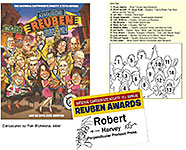

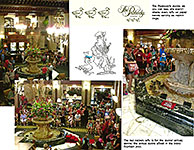
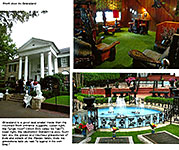
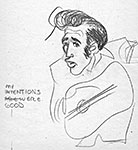
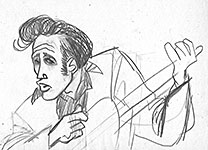
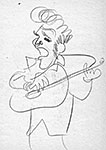
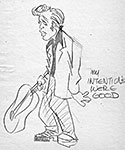
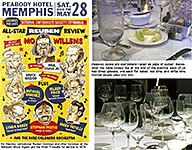
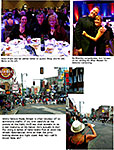
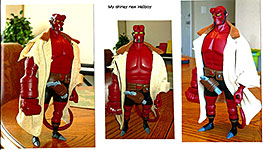
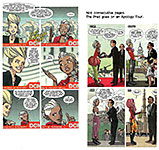
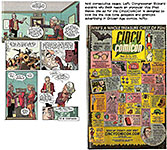
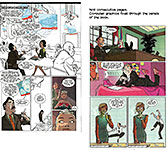
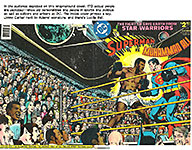
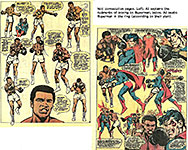
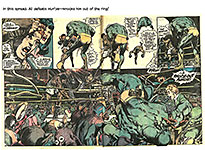
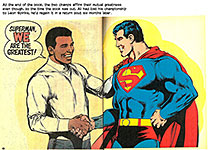
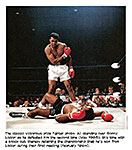
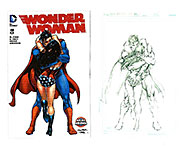
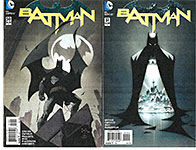
1.jpg)
2.jpg)
3.jpg)
4.jpg)
5.jpg)
6.jpg)
1.jpg)
2.jpg)
3.jpg)
